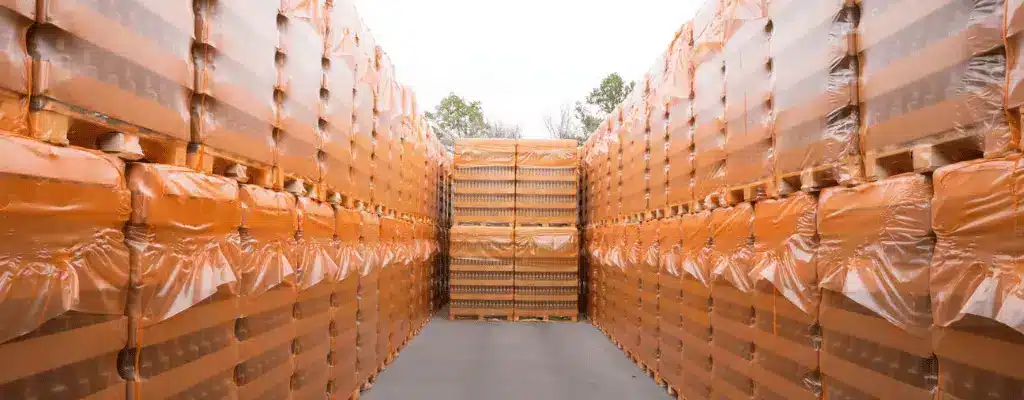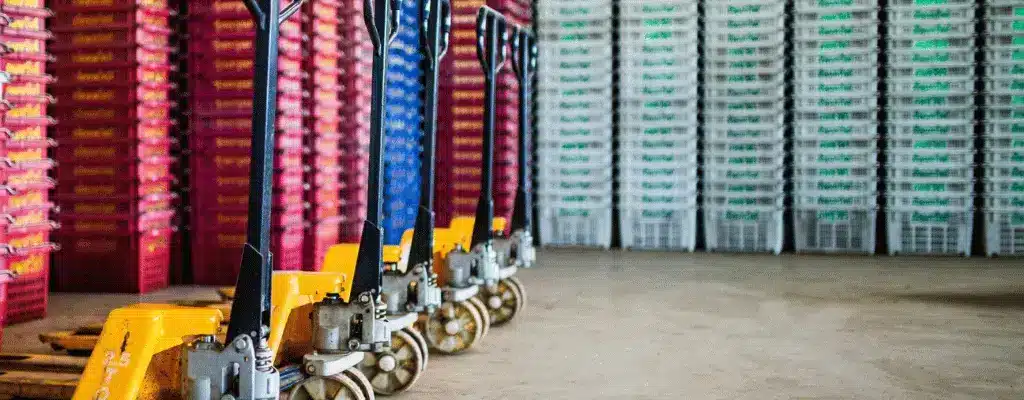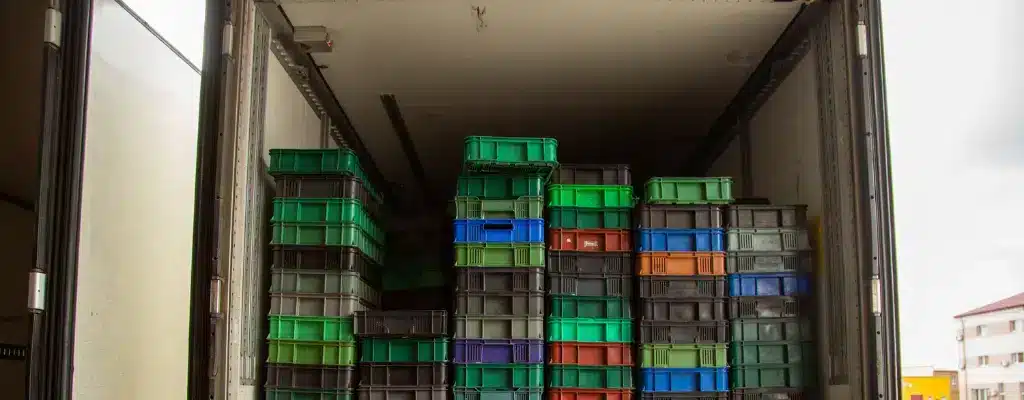In today’s world of expanding global markets and increasing demand for fresh, high-quality products, the shipping of perishable goods has become a vital component of various industries. From agricultural and livestock products to food and pharmaceuticals, a wide range of goods require transportation under specific temperature and environmental conditions to maintain their freshness, quality, and nutritional value and reach consumers around the world.

In this context, transport companies play a key role. Mobin Asa Tarabar, with years of experience and expertise in cold chain logistics, is recognized as a leader in the perishable goods shipping industry in Iran. Leveraging modern equipment, an extensive fleet, and specialized personnel, we ensure that your sensitive goods reach their destination as quickly as possible and with the highest quality standards.
This comprehensive article provides an in-depth look at the topic of perishable goods shipping and, while providing key, practical information, introduces Mobin Asa Tarabar’s distinctive services in this vital area. By reading this article, you will gain a deeper understanding of the importance of properly transporting perishable goods, the challenges and solutions involved, and, with confidence, you will choose Mobin Asa as your business partner in this process.
What are Perishable Goods and Their Types?
Definition and Classification of Perishable Goods
Generally, perishable goods refer to any type of product that, if not properly maintained under controlled temperature and environmental conditions, rapidly loses its quality, nutritional value, or usability. Due to their biological and chemical nature, these goods are susceptible to spoilage, decay, mold growth, discoloration, and unpleasant odors and tastes, making them unsuitable for human consumption or commercial purposes.

Perishable goods can be divided into different categories based on their origin and characteristics:
- Agricultural Products: Includes all kinds of fresh fruits, vegetables, greens, grains, and oilseeds. Due to their high moisture content and enzymatic activity, these products are very sensitive to temperature and environmental conditions.
- Livestock Products: Includes red meat, white meat, fish, eggs, dairy products, and other animal byproducts. Due to their high protein and fat content, these goods are highly susceptible to bacterial growth and microbial spoilage.
- Protein Products: A subset of livestock products, but due to their special importance and sensitivity, they are categorized separately. Includes various types of meat, poultry, fish, and seafood that require storage at very low temperatures.
- Seafood Products: Includes various types of fish, shrimp, shellfish, and other seafood, which, due to their very rapid spoilage, require very fast and precise transport in the cold chain.
- Pharmaceutical and Medical Products: Many drugs, vaccines, and medical supplies require storage at specific temperatures to maintain their effectiveness and prevent degradation.
- Flowers and Ornamental Plants: These goods, due to their sensitivity to temperature, humidity, and light, are also classified as perishable goods and require special transport.
- Specific chemical products: Some temperature and light sensitive chemicals.
Common Examples of Perishable Goods
The table below shows more common examples of perishable goods along with their categorization and more detailed examples:
| Category of Perishable Goods | More Detailed Examples |
|---|---|
| Agricultural Products | Apples, oranges, bananas, strawberries, grapes, tomatoes, cucumbers, lettuce, spinach, broccoli, carrots, potatoes, onions, garlic, corn, brown rice, extra virgin olive oil |
| Livestock Products | Beef, lamb, chicken, turkey, salmon, tuna, shrimp, milk, yogurt, cheese, butter, cream, eggs |
| Protein Products | Beef steak, chicken fillet, turkey breast, trout, lobster, crab |
| Seafood Products | Fresh fish, frozen fish, fresh shrimp, frozen shrimp, oysters, crab meat, caviar |
| Pharmaceutical/Medical Products | Temperature-sensitive vaccines, insulin, certain antibiotics, chemotherapy drugs, diagnostic kits |
| Flowers and Ornamental Plants | Roses, lilies, tulips, orchids, houseplants sensitive to cold |
| Specialty Chemicals | Temperature sensitive active pharmaceutical ingredients, light sensitive laboratory chemicals. |
The Importance of the Cold Chain in Perishable Goods Shipping
The Role of Temperature in Maintaining Quality and Freshness
Temperature is the most important factor in maintaining the quality and freshness of perishable goods. Increased temperature accelerates the activity of enzymes and microorganisms, leading to spoilage, decay, and reduced nutritional value of goods. On the other hand, excessively low temperatures can also lead to cold damage in some goods (such as tropical fruits and vegetables).
Therefore, maintaining the cold chain at all stages of perishable goods transport, from origin to final destination, is of vital importance. The cold chain refers to a set of processes and equipment designed to maintain goods at the appropriate and controlled temperature throughout the transport route.
Different Stages of the Cold Chain from Production to Consumption
The cold chain includes various stages, each of which plays an important role in preserving the quality of the goods:
- Production and Harvesting: At this stage, after production or harvesting, goods must be quickly cooled and stored under appropriate temperature conditions.
- Packaging: Proper packaging plays an important role in maintaining temperature and preventing physical damage to goods during transport. Packaging should be thermally insulated and prevent moisture and contamination from entering.
- Cold Storage: Before transport, goods must be stored in cold storage with controlled temperatures. These warehouses must be equipped with appropriate cooling and ventilation systems.
- Refrigerated Transport: Transport is the main part of the cold chain. The use of refrigerated vehicles (such as refrigerated trucks, reefer containers, and aircraft equipped with temperature control systems) is essential to maintain the temperature of the goods along the route.
- Distribution and Storage at Retail Centers: After reaching the destination, goods must be stored at appropriate temperatures in distribution and retail centers to maintain their quality until they reach the consumer.
- Final Consumer: Even final consumers must store perishable goods in the refrigerator or freezer after purchase to prevent premature spoilage.
Failure to maintain the cold chain at any of these stages can lead to loss of product quality, reduced commercial value, and even create health risks for consumers.
Perishable Goods Shipping Services at Mobin Asa Tarabar
Mobin Asa’s Expertise and Experience in Transporting Various Types of Perishable Goods
Mobin Asa Tarabar, relying on years of experience and specialized knowledge in the field of transporting sensitive and perishable goods, is recognized as a reliable partner for businesses active in various industries. At Mobin Asa, we are aware of the vital importance of maintaining the quality and freshness of your goods, and by providing comprehensive and customized solutions, we ensure that your shipments will reach their destination safely and quickly.
Our expert team, with a complete understanding of the specific characteristics of each type of perishable goods, from agricultural and livestock products to food, pharmaceuticals, and chemicals, selects the best transport and storage method for your shipment. We pay attention to the smallest details and, by strictly adhering to standards and protocols, protect the health and quality of your goods along the way.
Mobin Asa’s Special Equipment and Facilities
Mobin Asa Tarabar, by utilizing state-of-the-art equipment and facilities, has provided a safe and secure platform for transporting your perishable goods:
- Modern Fleet of Refrigerated Trucks: We have an extensive fleet of refrigerated and temperature-controlled trucks with various capacities that are equipped with advanced temperature and humidity control systems. These trucks are regularly inspected and calibrated to ensure their proper functioning.
- Refrigerated Containers: For sea transport of perishable goods, we use refrigerated containers (Reefer Containers) with the ability to adjust temperature and humidity. These containers are specifically designed to maintain product quality on long sea voyages.
- Equipped Cold Storage Facilities: In various parts of the country, we have cold storage facilities with various capacities that are used for temporary storage of perishable goods before and after transport. These warehouses have online temperature and humidity monitoring systems.
- GPS Tracking Systems: All our vehicles are equipped with GPS tracking systems that allow real-time monitoring of the location and temperature conditions of the shipment. You can be aware of the status of your shipment at any time.
- Trained and Specialized Personnel: Mobin Asa’s specialized and experienced team, including professional drivers, logistics experts, and support staff, are fully trained in the transport of perishable goods and are familiar with the sensitivities and special requirements of this field.
Compliance with Standards and Health Requirements
Mobin Asa Tarabar is committed to full compliance with standards and health requirements in the transport of perishable goods. By obtaining valid certificates and permits from relevant organizations, we ensure that all our transport processes are carried out in accordance with the latest national and international guidelines and regulations.
Compliance with hygiene in the transport of perishable goods not only helps maintain the quality and health of the goods, but also prevents legal problems and heavy fines. Mobin Asa, with complete care and responsibility, observes all hygiene points at various stages of transport and prioritizes the health of society and its customers.
The Process of Transporting Perishable Goods at Mobin Asa
The process of transporting perishable goods at Mobin Asa Tarabar is designed to be simple, transparent, and efficient to provide maximum customer satisfaction:
- Request and Consultation: You contact our experts, register your request for transporting perishable goods, and benefit from free consultation on the best transport method, packaging, and storage conditions.
- Planning and Coordination: Our team, by carefully examining the characteristics of your shipment, performs detailed transport planning and makes the necessary arrangements with the origin, destination, and other relevant factors.
- Loading and Temperature Control: At the appointed time, Mobin Asa Tarabar’s refrigerated vehicles are present at the loading location, and the loading operation is carried out in full compliance with health and safety points. The temperature of the shipment is carefully controlled before, during, and after loading.
- Transport and Tracking: Your shipment moves towards its destination safely and quickly with Mobin Asa’s equipped fleet. You can use the online tracking system to see the real-time location of the shipment and its temperature conditions.
- Unloading and Delivery: At the final destination, the unloading operation is carried out carefully and the shipment is delivered to the consignee. Relevant documents are also provided to you.
- Support and Follow-up: Mobin Asa Tarabar’s customer support team will be with you throughout the transport process and will answer your questions and requests. We will also follow up on your satisfaction after delivery of the shipment.
Methods of Transporting Perishable Goods
Land Transport of Perishable Goods (with Refrigerated and Temperature-Controlled Trucks)
Land transport is one of the most common and cost-effective methods of transporting perishable goods over short and medium distances. Refrigerated and temperature-controlled trucks are the main vehicles used in this method.
Refrigerated trucks are equipped with powerful cooling systems that are capable of maintaining cargo temperatures in the range of 0 to 10 degrees Celsius (and lower in some cases). These trucks are suitable for transporting agricultural products, dairy products, fresh meat, and meat products.
Temperature-controlled trucks, in addition to a cooling system, also have a heating system and can control the temperature in a wider range (e.g., -20 to +20 degrees Celsius). This type of truck is more suitable for transporting goods more sensitive to temperature, such as pharmaceuticals, specialty chemicals, and some frozen food products.
Advantages of Land Transport of Perishable Goods:
- Relatively lower cost compared to air and sea transport
- Extensive accessibility and high flexibility in choosing the route and time
- Ability to transport small and large shipments
- Suitable for short and medium distances
Disadvantages of Land Transport of Perishable Goods:
- Limitations on long distances (especially in international transport)
- Longer transport time compared to air transport
- Susceptibility to weather conditions and traffic
Air Transport of Perishable Goods
Air transport is the fastest way to transport perishable goods, especially over long distances and internationally. Cargo aircraft are equipped with specialized temperature-controlled chambers that enable the goods to be transported at the required temperature. Air freight is ideal for highly sensitive and time-critical perishable goods such as fresh seafood, rare and special fruits, medicines and vaccines. The high speed of air freight minimizes the time it takes for goods to reach their destination and significantly increases the shelf life and quality of the goods.
Advantages of Air Transport of Perishable Goods:
- Very high speed and short transport time
- Suitable for long and international distances
- Maintain the quality and freshness of the goods due to the speed of transport
- Access to remote markets
Disadvantages of Air Transport of Perishable Goods:
- Much higher cost compared to land and sea transport
- Limitations on shipment volume and weight
- Dependence on flight scheduling and airports
- More security restrictions
Sea Transport of Perishable Goods (with Reefer Containers)
Sea transport is the most cost-effective method of transporting perishable goods in very large volumes and over long international distances. Reefer Containers are the main vehicles in this method.
Reefer containers are loaded onto specialized container ships, and the temperature inside the container is continuously controlled during sea voyages. Sea transport is suitable for goods that are less sensitive to time and are transported in large volumes, such as bulk fruits and vegetables, bulk agricultural products, and some frozen foods.
Advantages of Sea Transport of Perishable Goods:
- Much lower cost compared to air and land transport (especially for large volumes)
- Ability to transport very large volumes of goods
- Suitable for long international distances
Disadvantages of Sea Transport of Perishable Goods:
- Much longer transport time compared to land and air transport
- Very low speed
- Limitations in choosing routes and ports
- Susceptibility to sea weather conditions
Comparison Table of Different Methods of Transporting Perishable Goods
| Transport Method | Suitable Goods Type | Cost | Speed | Temperature and Freshness Considerations |
|---|---|---|---|---|
| Land (Truck) | Agricultural products, dairy, fresh meat, meat products, some pharmaceuticals | Low | Medium | Suitable for short and medium distances, requires precise temperature control, temperature ranges adjustable with temperature controlled trucks |
| Air (Airplane) | Fresh seafood, special fruits, pharmaceuticals, vaccines | Very High | Very High | Very high speed, maximum freshness preservation, high cost, volume and weight limitations |
| Sea (Container) | Bulk fruits and vegetables, bulk agricultural products, some frozen foods | Very Low | Very Low | Low cost, long transport time, suitable for large volumes and goods with less time sensitivity |
Packaging and Storage of Perishable Goods
The Importance of Proper Packaging for Preserving Product Quality
Packaging plays a very important role in maintaining the quality and freshness of perishable goods. Proper packaging should protect goods from harmful environmental factors such as temperature changes, humidity, light, impact, and contamination.
Features of Proper Packaging for Perishable Goods:
- Thermal Insulation: Preventing heat transfer and maintaining the internal temperature of the packaging.
- Moisture Resistance: Preventing moisture penetration and maintaining the proper humidity for the goods (if necessary).
- Light Protection: Preventing the effect of direct sunlight on product quality.
- Physical Resistance: Protecting goods from impact, pressure, and vibration during transport.
- Hygienic and Safe: Made of hygienic and non-toxic raw materials, no chemical transfer to the goods.
- Environmentally Friendly: Preferably recyclable or biodegradable.
Common Types of Packaging for Perishable Goods:
- Insulated Cardboard Boxes: Suitable for transporting fruits, vegetables, and other agricultural products.
- Styrofoam Coolers: Suitable for transporting fresh seafood, meat, and frozen poultry.
- Vacuum Packs: Suitable for increasing the shelf life of meat, poultry, fish, and some processed products.
- MAP (Modified Atmosphere Packaging): Packaging with a modified atmosphere to increase the shelf life of fruits, vegetables, and meat.
- Packs Containing Gel Ice: To maintain low temperatures in small packages and transport sensitive samples.
- Stretch and Shrink Films: For packaging pallets and protecting cargo from dust and moisture.
How to Store and Warehouse Perishable Goods
Proper storage and warehousing of perishable goods are complementary to the cold chain and proper packaging. Cold storage facilities should be equipped with advanced temperature and humidity control systems, proper ventilation, and online monitoring systems.
Key Points in Storing and Warehousing Perishable Goods:
- Observing Recommended Temperatures: Each type of perishable goods has its own specific storage temperature. Observing these temperatures is essential for maintaining quality and preventing spoilage.
- Humidity Control: High humidity can cause mold and mildew growth in some goods. Controlling warehouse humidity and using moisture-absorbing materials (if necessary) is important.
- Proper Ventilation: Proper air circulation in the warehouse helps to maintain uniform temperature and prevent the accumulation of gases from product respiration.
- Proper Arrangement of Goods: Goods should be arranged in the warehouse in a way that allows air to circulate properly and provides easy access to goods for inspection and removal.
- Pest and Disease Control: Warehouses should be regularly disinfected and pest-controlled to prevent contamination of goods by pests and insects.
- FIFO System (First In, First Out): In warehousing perishable goods, the “First In, First Out” principle should be observed to prevent the expiration of goods in the warehouse.
- Temperature and Humidity Monitoring: Online monitoring systems should continuously monitor the temperature and humidity of the warehouse and alert in case of any deviation from the permissible range.
Frequently Asked Questions (FAQ)
What types of goods are classified as perishable goods?
As mentioned earlier, perishable goods refer to any type of product that, in the absence of proper storage in controlled temperature and environmental conditions, rapidly loses its quality, nutritional value or usability. Common examples include agricultural produce (fruits, vegetables), livestock products (meat, poultry, fish, dairy), protein products, marine products, pharmaceuticals and medical products, flowers and ornamental plants, and certain specialty chemicals.
Why is the cold chain important in the transport of perishable goods?
The cold chain is critical for maintaining the quality, freshness, nutritional value, and safety of perishable goods. Temperature is the most important factor in the spoilage of these goods, and the cold chain is a series of processes and equipment designed to keep the goods at a suitable, controlled temperature throughout the transport route. Failure to maintain the cold chain can lead to financial losses, decreased customer satisfaction, and even create health hazards.
What services does Mobin Asa Tarabar offer for the transport of perishable goods?
Mobin Asa Tarabar, as a leading company in cold chain logistics, offers a complete range of perishable goods transport services, including:
- Land transport with refrigerated and temperature-controlled trucks
- Air transport with aircraft equipped with temperature control systems
- Sea transport with refrigerated containers
- Cold storage warehousing
- Specialized packaging
- Cold chain consulting and planning
- Online cargo tracking
Mobin Asa, relying on experience, expertise, and modern equipment, ensures that your perishable goods will reach their destination with the highest quality standards and as quickly as possible.
How can I request a quote from Mobin Asa Tarabar for the transport of perishable goods?
For price inquiries and free consultation regarding the transport of your perishable goods from Mobin Asa Tarabar, you can take action through various methods:
- Phone Call: Call the phone numbers listed on the Mobin Asa Tarabar website and talk to our sales experts.
- Submit an Online Request Form: Complete and submit the cargo transport request form on the perishable goods services page of the Mobin Asa Tarabar website.
- Send an Email: Send your request to the company’s email address.
- Visit in Person: Visit the head office or branches of Mobin Asa Tarabar.
Our experts will contact you as soon as possible and provide the necessary information.






